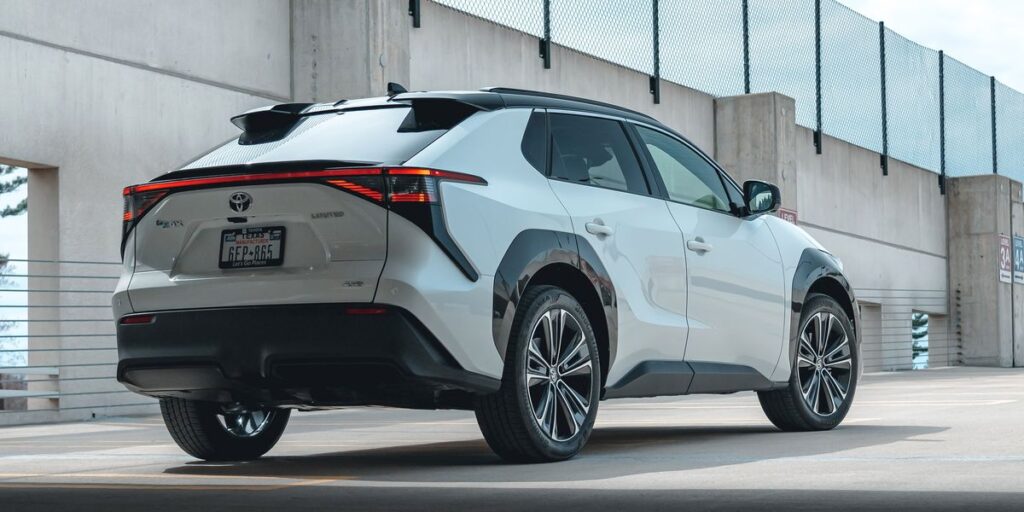Toyota Stays Modest about EVs as It Relaunches bZ4X after Recall

Toyota’s bZ4X EV was subject to a recall and stop-sale last year.It’s now back on sale, but sales expectations are modest for 2023.Toyota prefers to emphasize its hybrid sales over its plans to expand its EV lineup.
After a recall and stop-sale thwarted the launch of Toyota’s first mass-market EV last year, the company is starting over as it starts to sell the 2023 bZ4X to customers in the U.S. once again. But even now that there’s a fix for the faulty wheel hub bolts and dealerships have bZ4Xs in stock, expectations are modest for this new electric vehicle—as are Toyota’s broader plans for EVs overall.
During an interview at the Washington D.C. auto show last week, Toyota executives discussed how the bZ4X fits in with the company’s wider electrification strategy. We spoke with Jason Keller, director of dealer policy and government affairs, and Rick Gezelle, senior principal engineer of regulatory affairs, about how the recall “hurt the momentum” of the bZ4X’s launch and how expectations are now being set as the car is relaunched.
Why Toyota Prefers Hybrids
Toyota is aiming to sell only 10,000 units of the bZ4X this year, meaning it could be rarer than even the GR86 sports car, which sold nearly 12,000 units in 2022. That would also put the bZ4X significantly behind the 2022 sales performance of several of its EV rivals: Ford sold just under 40,000 Mustang Mach-Es and Volkswagen sold more than 20,000 ID.4 models, and sales of those SUVs could increase even more in 2023 due to expanded production.
Toyota likes to emphasize its strong hybrid sales instead. The company sold over 500,000 electrified vehicles in 2022, the vast majority of which were hybrids and plug-in hybrids (the fuel-cell Mirai is also included in this number, but only made up just over 2000 units of that total). Toyota has been clear about how it plans to prioritize hybrid production over EVs as a way of managing the finite amount of raw materials, particularly for batteries, that go into building an electrified vehicle. With the same amount of materials needed for a single bZ4X, Toyota says it can build 90 Prius hybrids or 60 plug-in-hybrid RAV4 Primes. The company believes that maximizing hybrid sales is a better play for reducing carbon emissions, at least given current market conditions.
Even though the sales expectations are small, Toyota acknowledges that a renewed push to get the word out about the bZ4X is still necessary after the recall and stop-sale grounded the initial rollout. There will be a renewed marketing campaign launching in May to make sure that customers haven’t forgotten that the bZ4X exists. We found a few hundred new bZ4X models for sale through a search of nationwide dealer inventory, and a slightly lower number of the Toyota’s twin, the Subaru Solterra. While Subaru says that the Solterra is available in all 50 states, Toyota describes the bZ4X on its website as, “available in select states only and in extremely limited quantities.”
No More Tax Credit
The bZ4X also enters a different regulatory landscape than it would have had it launched on schedule. For one thing, it no longer qualifies for the $7500 federal tax credit. Under the old rules, Toyota ran out of time for the bZ4X to qualify because, in July 2022, it reached the sales volume cap due to sales of its plug-in hybrids. Per the new parameters of the recently passed Inflation Reduction Act (IRA), the bZ4X and Solterra do not qualify for the credit because they are built in Japan, not the U.S.
Keller did mention a different subset of the IRA for commercial vehicles that could potentially apply for bZ4X customers who choose to lease. But the details around this loophole remain murky—not to mention confusing for consumers. Toyota has not yet announced any plans for U.S. EV production that could make the bZ4X—or future bZ models such as the rumored bZ3X small SUV and bZ5X three-row SUV—eligible for the broader tax credit.
Recall and Fix
The bZ4X initially went on sale in spring 2022, but in June the company announced a recall involving a flaw with the wheel hub bolts that could cause the wheels to detach from the car. Only 258 cars were involved in the U.S., but those early customers were told to stop driving their cars. Toyota offered these owners an extended warranty, loaner vehicles, reimbursements, loan/lease credits, complimentary charging, and even initiated a buyback program for those who wanted to give back their bZ4Xs (the company did not disclose how many of those customers opted to participate). The closely related Subaru Solterra, the bZ4X’s twin, was also affected by the recall, but Subaru had yet to sell any units in the U.S. before it was announced.
It took until October for Toyota to come up with a fix, which involves replacing the hub bolts and wheels. The company started implementing the fix late in 2022 and the cars went back on sale in November, with Toyota moving 988 units of the bZ4X in the fourth quarter and Subaru selling 919 Solterras (Subaru has not shared sales targets for the Solterra in the U.S.).
Only time will tell if this rocky launch mars the bZ4X’s larger narrative, but either way this new model tells the story of where Toyota’s priorities stand. As the industry continues to shift towards electrification, Toyota appears to be hedging its bets until it becomes clear which solution will win out in the end.
This content is imported from poll. You may be able to find the same content in another format, or you may be able to find more information, at their web site.



